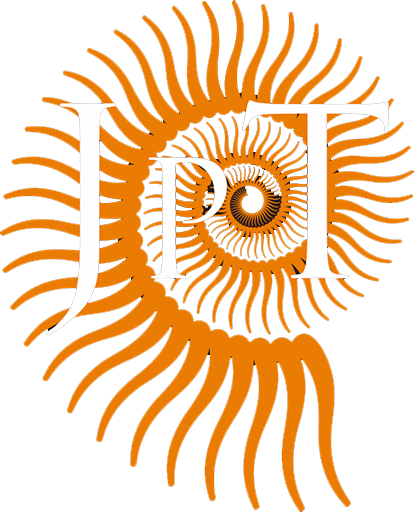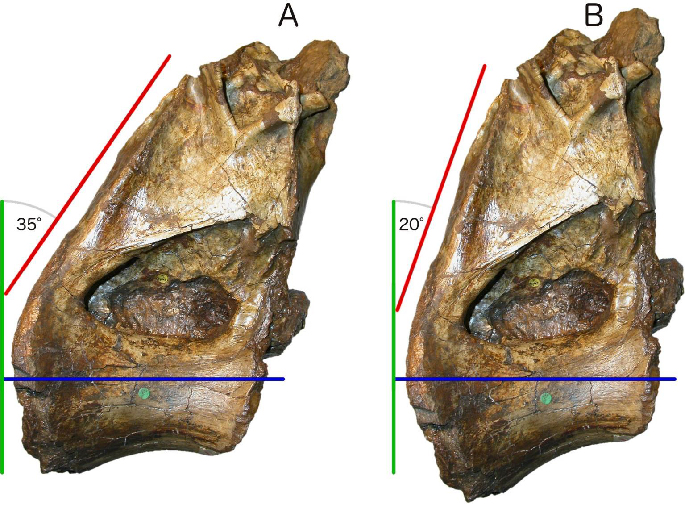JPT No. 25 – What do we mean by the directions “cranial” and “caudal” on a vertebra?
Michael P. Taylor1* & Mathew J. Wedel2
1 – Department of Earth Sciences, University of Bristol, Bristol BS8 1RJ, UK.
2 – College of Osteopathic Medicine of the Pacific and College of Podiatric Medicine, Western University of Health Sciences, Pomona, California, USA.
Emails: dino@miketaylor.org.uk (MT); mathew.wedel@gmail.com (MW)
ABSTRACT
When describing and illustrating vertebrae, it is important to consistently depict their orientation, so we can objectively assess and compare the slope of the neural arch, neural canal, or articular surfaces. However, differing vertebral shapes across taxa and across regions of the spinal column make it difficult to maintain consistency, or even define what we mean by the directions “cranial” and “caudal”. Consequently, characters such as “Neural arch slopes cranially 30° relative to the vertical” are disputable rather than objective measurements. Cranial and caudal are defined as directed along the horizontal axis, but several different definitions of “horizontal” are possible:
- Long axis of centrum is horizontal. This is appealing for elongate vertebrae such as sauropod cervicals, but is not always well defined, and is difficult to determine for craniocaudally short vertebrae such as most caudals.
- Articular surfaces of centrum are vertical. Difficult to determine when dealing with facets that are concave or (worse) convex; and ambiguous for “keystoned” vertebrae in which the facets are not parallel.
- Neural canal is horizontal. Anatomically informative, but difficult to determine in vertebrae that have not been fully prepared or CT-scanned, and impossible to see in lateral view. Ambiguous for vertebrae where the dorsal and ventral margins of the canal are not straight or not parallel.
- Similarity in articulation (“horizontal” is defined as a line joining the same point on two similarly oriented copies of the same vertebra when optimally articulated). This is less intuitive than definitions 1–3, but takes the entire vertebra into account.
We advocate explicitly stating a definition and using it consistently. In most cases, definition 3 (“Neural canal is horizontal”) best reflects anatomical and developmental realities, and it is therefore preferred. Low-tech methods can be used to determine neural canal orientation with adequate precision for most purposes.
RESUMO [in Portuguese]
Ao descrever e ilustrar vértebras, é importante descrever de forma consistente a sua orientação, para que possamos avaliar e comparar objectivamente a inclinação do arco neural, canal neural, ou superfícies articulares. Entretanto, as diferentes formas de vértebrais dos táxons e das regiões da coluna vertebral tornam difícil manter consistência, ou mesmo definir o que queremos dizer com as direcções “cranial” e “caudal”. Consequentemente, caracteres tais como “curvatura do arco neural cranialmente 30° em relação à vertical” são discutíveis em vez de medidas objectivas. Cranial e caudal são definidos como direcionados ao longo do eixo horizontal, mas várias definições diferentes de “horizontal” são possíveis
- O eixo longo do centro vertebral é horizontal. Isto é interessante para vértebras alongadas, como as cervicais dos saurópodes, mas nem sempre é bem definido, e é difícil de determinar para vértebras curtas craniocaudalmente, como a maioria das caudais.
- As superfícies articulares do centro vertebral são verticais. Difícil de determinar quando se trata de facetas que são côncavas ou (pior) convexas; e ambíguo para as vértebras com a forma de uma chave de um arco, nas quais as facetas não são paralelas.
- O canal neural é horizontal. Anatomicamente informativo, mas difícil de determinar em vértebras que não tenham sido completamente preparadas ou digitalizadas por TC, sendo impossível de visualizar em vista lateral. Ambíguo para vértebras cujas as margens dorsal e ventral do canal não são rectas ou não são paralelas.
- Semelhança na articulação (“horizontal” é definido como uma linha que une o mesmo ponto em duas cópias da mesma vértebra com orientações semelhantes, quando articuladas de forma óptima). Isto é menos intuitivo do que as definições 1–3, mas leva em conta a vértebra inteira.
Defendemos o uso de explícito de uma definição e a sua utilização de forma consistente. Na maioria dos casos, a definição 3 (“O canal neural é horizontal”) reflecte melhor a realidade da anatomia e do desenvolvimento, pelo que é preferível. Métodos de baixa tecnologia podem ser utilizados para determinar a orientação do canal neural com precisão adequada para a maioria dos fins.

